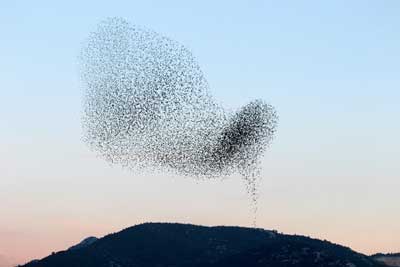| Mar 12, 2019 | |
Harnessing active matter for nanoscale applications(Nanowerk News) In the field of physics, everything that has mass and takes up space is matter. Active matter consists of many self-propelled entities uniting to create large-scale structures and movements, such as a group of molecules interacting to enable muscle contraction, or a flock of birds synchronizing in flight to form complex patterns. |
|
| Active matter has become a major subject of research over the past several years, promising to revolutionize everything from medicine to robotics. Physicists theorize that by converting the internal energy of active matter into motion, they can ultimately harness active matter to create materials that behave like living organisms, and maybe even self-replicating nanomachines. | |
 |
|
| The collective behavior of a flock of birds synchronizing in flight to form patterns is an example of active matter. | |
| John Gibbs, assistant professor of physics at Northern Arizona University, was recently awarded a $502,000 grant from the National Science Foundation (NSF) to build on research he’s been conducting in the field of active matter. The award will support a five-year project during which Gibbs and his team will develop a unique system of microscale self-propelled particles (SPPs) that will enable them to control the movement and interaction of colloidal SPPs (moving microparticles suspended in a liquid) in unprecedented ways. | |
| Gibbs’ system will combine several innovative properties, including controllable particle speed, made possible by modulating the intensity of an external activating light source; a new fuel-free method of microscale motion; and tunable long-range interactions between the particles. | |
| “Our main innovation is employing repulsive magnetic dipole-dipole interactions so that our active colloidal particles do not come into direct contact, which overcomes the limitation of the particles jamming or ‘freezing.’ More importantly, through targeted engineering, we can exploit this same repulsive force so that the particles show highly correlated velocity directions; in other words, the particles automatically align their motion in the same direction, mimicking systems encountered in nature,” said Gibbs. | |
Potential application in nanofabrication, nanomachinery |
|
| “This field is expanding rapidly partly because systems of this type offer new opportunities for investigating interacting SPPs,” said Gibbs. “Developing systems in which mobility and particle-particle interactions can be easily and systematically controlled is expected to advance the discovery of new physical phenomena. This research is even expected to help shine light on seemingly unrelated collective behavior related to systems with many moving parts, such as understanding the movement of people in large crowds.” | |
| Although Gibbs’ work is still in the exploratory stage, he sees some potential for technological advancement and possible commercialization down the road. One exciting potential application is in nanofabrication—methods for manufacturing on the nanometer scale (one nanometer is 10-9 meter, or a millionth of a millimeter)—that may open the door to new technologies, such as high-sensitivity molecular detection devices, among many others. | |
| “I envision being able to utilize our unique system for unprecedented nanofabrication capabilities. Even further into the future, I believe this project will help sow the seeds of complex nanomachinery with many cooperating moving parts,” said Gibbs. | |
| Several graduate students are working on this project with Gibbs—MS student Brad Landry; Taylor Thomas, who is expected to be in the very first class of students in the new Applied Physics and Materials Science Ph.D. program, which begins in fall 2019; and bioengineering Ph.D. student Sam Sarkar. The project also includes undergraduate students John Castañeda, Mingyang Li and Andrew Leeth Holterhoff from the Gibbs Research Lab. | |
Scientists to disseminate research across Northern Arizona communities |
|
| “Many of the experimental techniques and methods in this project are excellent for introducing students to research for the first time,” said Gibbs, “so not only will undergraduates be an integral part of this work, but the researchers involved in this project will also work closely with STEM City to make bi-yearly visits to a middle school in Flagstaff, where the students will have the opportunity to take part in a research project on active matter.” | |
| The team will also disseminate this research through outreach to K-12 students and the local community via the Flagstaff Festival of Science. | |
| Gibbs, an experimental condensed matter physicist, joined the faculty of NAU’s Department of Physics and Astronomy in 2014. He is also a core member of the recently launched Center for Materials Interfaces in Research and Applications (¡MIRA!). Gibbs’ research interests cover the physics and applications of nanomaterials, including optical and mechanical properties, metamaterials and propulsion at the nanoscale. |
| Source: Northern Arizona University | |
|
Subscribe to a free copy of one of our daily Nanowerk Newsletter Email Digests with a compilation of all of the day's news. |
